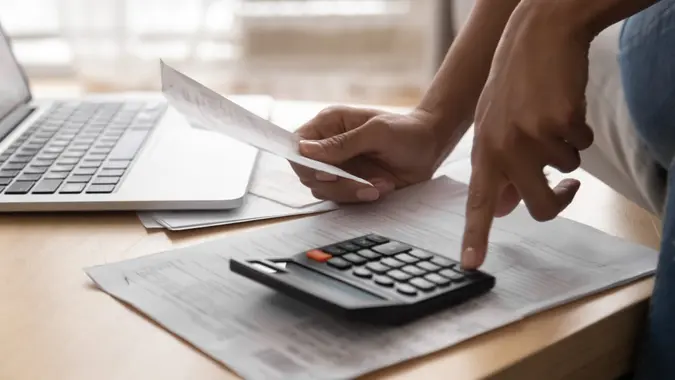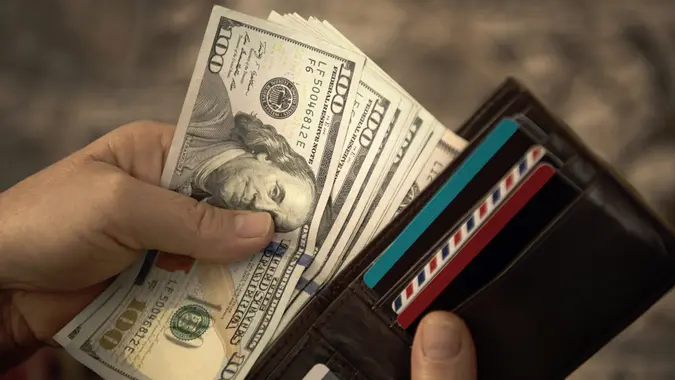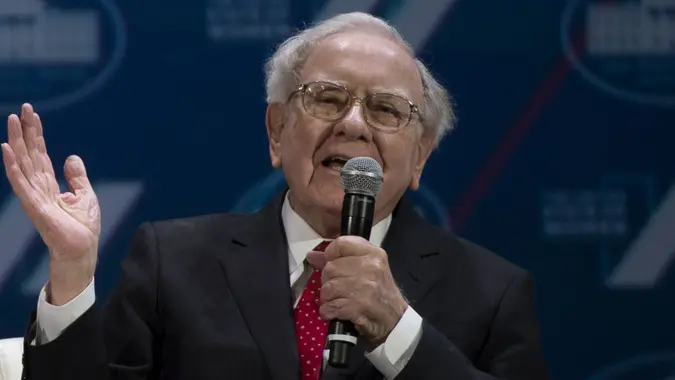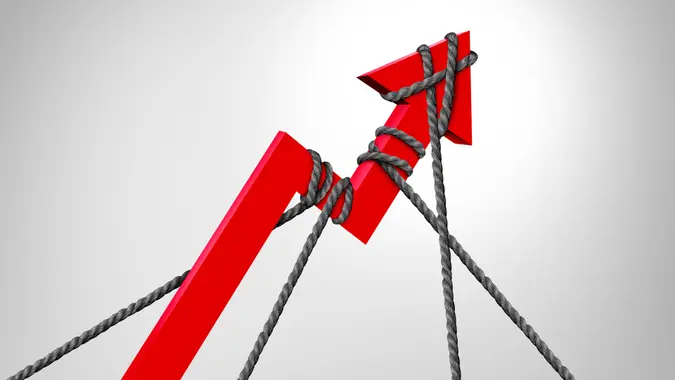Recession vs. Depression: What Sets Them Apart and Why It Matters

Commitment to Our Readers
GOBankingRates' editorial team is committed to bringing you unbiased reviews and information. We use data-driven methodologies to evaluate financial products and services - our reviews and ratings are not influenced by advertisers. You can read more about our editorial guidelines and our products and services review methodology.

20 Years
Helping You Live Richer

Reviewed
by Experts

Trusted by
Millions of Readers
Whenever the economy is in turmoil, you’ll hear the terms “recession” and “depression” tossed around.
Is there a real difference, though? Here’s a breakdown of each.
What Is a Recession?
You may be surprised to learn that there isn’t an official definition of a recession. The National Bureau of Economic Research, or NBER, says “a recession involves a significant decline in economic activity that is spread across the economy and lasts more than a few months.”
The more common definition used by economists is two consecutive quarters of declining gross national product, or GDP.
The NBER considers a recession to broadly influence the economy, and to be based on a number of measures of economic activity. These measures include:
- Employment
- Personal income
- Consumer spending
- Wholesale and retail sales
- Industrial production
What Is an Economic Depression?
A depression is an economic contraction similar to a recession, but longer and more severe. Like recession, depression doesn’t have a specific definition, but it’s characterized by a sharp drop in GDP, high unemployment, business failures and steep stock market declines.
There has only been one depression in the United States, which is the Great Depression. It began in 1929 and lasted through World War II. There were several recessions within that time period, but the depression itself lasted throughout that time.
4 Common Causes of a Recession
A recession can be caused by a number of things, and often there is more than one cause at play. Here are some of the economic causes of a recession.
1. Economic Uncertainty
Economic shocks, such as sudden geopolitical events, or situations like the COVID-19 pandemic. Economic markets don’t like uncertainty, so these unexpected situations often cause a downturn.
2. Rising Interest Rates
Inflation may contribute to a recession, but more often, the culprit is the interest rates that central banks raise to try to curb inflation. These high rates depress spending, which will reduce inflation but can also tip the economy into recession.
3. Bursting Asset Bubbles
When economic markets like the stock market or the housing market, for example, become inflated rapidly, they will often burst. When that happens, a recession is likely to follow. The 2008 housing crisis that led to a recession is a good example of this.
4. Debt Defaults and Credit Crises
If the United States defaulted on its debt, it would likely push the country into a recession, possibly significant. A default would likely lead to a sharp increase in unemployment and chaos in the financial markets. Even if the default were limited to the U.S., the impact would be global.
5 Telltale Signs of a Recession
How can you be certain that a recession is happening? It’s helpful to look at signs that have historically indicated a recession before to see if one might be imminent. These are some of those signs:
1. Inverted Yield Curve
The yield curve shows the interest rate on government bonds over the length of the bond. Typically, shorter-term bonds pay a lower interest rate, because the longer the government can hold your money, the more they’re willing to pay for the pleasure.
When interest rates on shorter-term bonds rise to the point where they are higher than the rates on longer-term bonds, the yield curve is said to invert. An inverted yield curve indicates that interest rates are likely to drop significantly in the near future, which often indicates a recession.
2. Rising Unemployment Rates
Unemployment is a lagging economic indicator, which means it tends to be an effect of an economic condition, not a cause. Watching unemployment rates can be a tipoff to an impending recession.
Did You Know?
The Sahm Rule, named for economist Claudia Sahm, says if the three-month moving average of the unemployment rate increases by 0.5 percentage points or more over its 12-month low, a recession is occurring.
3. Decreased Consumer Confidence
When consumer confidence falls, people cut back on their spending, which depresses demand. This can lead to decreasing production and increased unemployment, as companies lay off due to lower demand.
4. Decline in Industrial Production
When demand declines, industrial production declines as well. This can lead to unemployment as companies do not need as many workers to produce fewer goods.
5. Falling Corporate Profits
When demand declines, companies may cut prices to try to entice consumers to buy. With costs staying the same, lower prices mean lower profits for corporations.
How Long Does a Recession Last?
Since 1945, the average recession has lasted about 11 months. From 1850 to 1945, the average was about 21 months, but that included the Great Depression, which technically included several recessions, one lasting 44 months.
Recession vs. Depression: Key Differences
This table shows the key differences between a recession and a depression.
| Recession | Depression | |
|---|---|---|
| Severity | Decline in economic activity, but generally manageable within the existing economic framework. | Catastrophic economic collapse, leading to widespread financial ruin and societal distress. |
| Duration | Lasts an average of 11 months. | The Great Depression lasted over a decade. |
| GDP impact | Often defined by two consecutive quarters of negative GDP growth. | Drastic and sustained drop in GDP, such as the 30% drop during the Great Depression. |
| Unemployment rate | Unemployment rises but typically remains in the single digits, under 10%. | Unemployment skyrockets, reaching 25% in the Great Depression. |
| Impact on society | Financial hardship, job losses, and reduced consumer spending, but the general economic and social structure remains largely intact. | Widespread business and personal bankruptcies, mass unemployment and social unrest. |
| Frequency | A common part of the normal business cycle, occurring on average every six and a half years. | The only one in modern history was the Great Depression of the 1930s. |
What Recession vs Depression Can Teach You About Being Financially Ready
Now that you know that a depression is a more severe and prolonged version of a recession, but also much less likely, what can you do to prepare?
Don’t Panic
Recessions are fairly commonplace — you’ve already lived through a few. A depression is unlikely because they are rare, but the many safeguards put in place after the Great Depression minimize the risk even more.
Organize Your Finances
Have an emergency fund of at least three to six months’ worth of expenses — more is better if you see signs a recession is imminent. And watch for the signs so you’ll know what may or may not be coming.
Stay Financially Strong in Any Situation
Work with an advisor or learn on your own, but understand investment best practices like portfolio diversification and dollar-cost averaging.
Knowing the difference between a recession and a depression, and the warning signs that one may be coming, will help you weather the inevitable financial storm, whenever it arrives.
FAQs on Recession vs. Depression
Still not how recession and depression are different? Here are some answers that might help.- How is an economic depression different from a typical recession?
- A depression is much more severe and longer in duration than a recession. Fortunately, it's also much less common.
- What factors are often cited as the causes of recession?
- Recessions are part of the normal business cycle, but can be precipitated by geopolitical events, rising interest rates, and a decline in consumer confidence.
- How does inflation play a role in a recession?
- Inflation usually doesn't cause a recession, but it can precede one. When inflation rises, central banks often raise interest rates to slow inflation. This increase in rates can tip the economy into recession, but there are usually other factors that contribute.
Our in-house research team and on-site financial experts work together to create content that’s accurate, impartial, and up to date. We fact-check every single statistic, quote and fact using trusted primary resources to make sure the information we provide is correct. You can learn more about GOBankingRates’ processes and standards in our editorial policy.
- National Bureau of Economic Research (NBER). "Business Cycle Dating."
- International Monetary Fund (IMF). "Recession: When Bad Times Prevail."
- Financial Times. "An Inverted Yield Curve: Why Investors Are Watching Closely."
- Congressional Research Service (CRS). 2024. "Introduction to U.S. Economy: The Business Cycle and Growth."
- FDR Presidential Library & Museum. "Great Depression Facts."
 Written by
Written by  Edited by
Edited by 

























